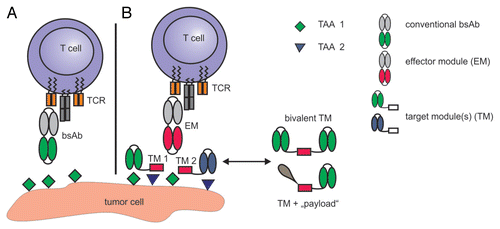Figures & data
Figure 1. T-cell recruitment by conventional bispecific antibodies and a novel modular system. (A) T cell-engaging bispecific antibodies (bsAbs) are fusion proteins comprising 2 single-chain variable fragments (scFvs). One of such scFvs is directed against an activating receptor of T cells, most commonly the CD3 molecule, while the other is specific for a tumor-associated surface antigen. (B) In our modular T-cell recruitment system, the 2 binding arms of a conventional bsAb are split into 2 separate units. The first unit is an effector module (EM) in the bsAb format, with one scFv specific for CD3 and one for a 10-amino acid motif from the human nuclear protein La (also known as Sjögren’s syndrome antigen). The second unit is a target module (TM) that consists of an antigen-binding domain, e.g., a scFv, coupled to the La epitope recognized by the EM. In this setting, the cross-linkage of T lymphocytes and their targets is mediated by the interaction between the T cell-recruiting EM and the target cell-binding TM. TMs directed against different target antigens can be easily exchange to avoid the emergence of antigen-loss tumor escape variants. Moreover, TMs can be functionalized with additional payloads, e.g., T cell-activating ligands, and can be rendered bivalent, to increase the avidity of binding, as well as bi-or multispecific, to recruit T cells against several antigens simultaneously.
